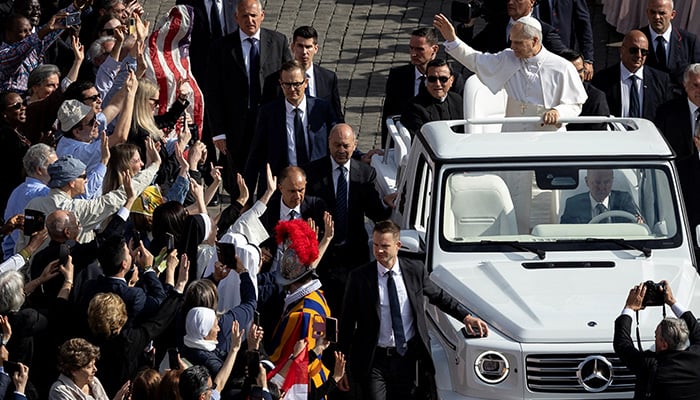
Pope Leo XIV formally began his reign on Sunday by reaching out to conservatives who felt orphaned under his predecessor, calling for unity, vowing to preserve the Catholic Church’s heritage and not rule like “an autocrat”.
After a first ride in the popemobile through an estimated crowd of up to 200,000 in St Peter’s Square and surrounding streets, Leo was officially installed as the 267th pontiff of the Roman Catholic Church at an outdoor Mass.
Well-wishers waved US and Peruvian flags, with people from both countries claiming him as the first pope from their nations. Born in Chicago, the 69-year-old pontiff spent many years as a missionary in Peru and also has Peruvian citizenship.
Robert Prevost, a relative unknown on the world stage who only became a cardinal two years ago, was elected pope on May 8 after a short conclave of cardinals that lasted barely 24 hours.
He succeeded Francis, an Argentine, who died on April 21 after leading the Church for 12 often turbulent years during which he battled with traditionalists and championed the poor and marginalised.
In his sermon, read in fluent Italian, Leo said that as leader of the world’s 1.4 billion Roman Catholics, he would continue Francis’ legacy on social issues such as combating poverty and protecting the environment.
He vowed to face up to “the questions, concerns and challenges of today’s world” and, in a nod to conservatives, he promised to preserve “the rich heritage of the Christian faith”, repeatedly calling for unity.
Crowds chanted “Viva il Papa” (Long Live the Pope) and “Papa Leone”, his name in Italian, as he waved from the open-topped popemobile ahead of his inaugural Mass, which was attended by dozens of world leaders.
Among those in the crowds on Sunday were many pilgrims from the US and Peru.
Dominic Venditti, from Seattle, said he was “extremely excited” by the new pope. “I like how emotional and kind he is,” he said. “I love his background.”
Since becoming pope, Leo has already signalled some key priorities for his papacy, including a warning about the dangers posed by artificial intelligence and the importance of bringing peace to the world and to the Church itself.
Saying he was taking up his mission “with fear and trembling”, Leo used the words “unity” or “united” seven times on Sunday and the word “harmony” four times.
“It is never a question of capturing others by force, by religious propaganda or by means of power. Instead, it is always and only a question of loving, as Jesus did,” he said, in apparent reference to a war of words between Catholics who define themselves as conservative or progressive.
Conservatives also accused Francis of ruling in a heavy-handed way and lamented that he belittled their concerns and did not consult widely before making decisions.
Referring to St Peter, the 1st century Christian apostle from whom popes derive their authority, Leo said: “Peter must shepherd the flock without ever yielding to the temptation to be an autocrat, lording it over those entrusted to him. On the contrary, he is called to serve the faith of his brothers and sisters, and to walk alongside them.”
Many world leaders attended the ceremony, including the presidents of Israel, Peru and Nigeria, the prime ministers of Italy, Canada and Australia, German Chancellor Friedrich Merz and European Commission President Ursula von der Leyen.
European royals also took their place in the VIP seats near the main altar, including Spanish King Felipe and Queen Letizia.
Leo shook many of their hands at the end of the ceremony, and hugged his brother Louis, who had travelled from Florida.
As part of the ceremony, Leo received two symbolic items: a liturgical vestment known as a pallium, a sash of lambswool representing his role as a shepherd, and the “fisherman’s ring”, recalling St Peter, who was a fisherman.
The ceremonial gold signet ring is specially cast for each new pope and can be used by Leo to seal documents, although this purpose has fallen out of use in modern times.
It shows St Peter holding the keys to Heaven and will be broken after his death or resignation.



